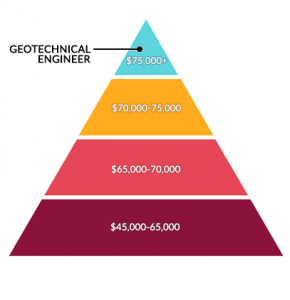Some Known Incorrect Statements About Geotheta
Some Known Incorrect Statements About Geotheta
Blog Article
4 Easy Facts About Geotheta Explained
Table of ContentsOur Geotheta DiariesGeotheta Things To Know Before You BuyRumored Buzz on GeothetaThe Best Guide To GeothetaThe smart Trick of Geotheta That Nobody is Discussing

They perform website investigations, collect samples, execute lab tests, and assess information to review the viability of the ground for construction projects - Consulting Engineer. Based upon their searchings for, geotechnical designers provide recommendations for foundation design, slope security, keeping structures, and mitigation of geotechnical hazards. They collaborate with other professionals, such as designers, structural designers, and construction groups, to guarantee that geotechnical factors to consider are incorporated right into the total job style and execution
By assessing the actions and homes of soil and rock, they can identify potential geotechnical hazards such as landslides, dirt negotiation, or incline instability. Their proficiency assists avoid failures or crashes that might threaten lives and residential property. Below are some comprehensive tasks and responsibilities of a geotechnical designer: Site Investigation: Geotechnical designers conduct site examinations to gather information on subsurface conditions.
They analyze the information to recognize the residential or commercial properties and behavior of the dirt and rock, including their toughness, leaks in the structure, compaction attributes, and groundwater problems. Geotechnical Analysis and Design: Geotechnical engineers analyze the data collected throughout website examinations to analyze the security and viability of the website for building and construction tasks. They perform geotechnical estimations and modeling to review aspects such as bearing capability, settlement, incline stability, side planet pressures, and groundwater flow.
Getting The Geotheta To Work
Structure Style: Geotechnical designers play an important duty in making foundations that can securely sustain the designated framework. They evaluate the soil problems and load demands to determine the proper structure type, such as superficial foundations (e.g., grounds), deep foundations (e.g (https://www.easel.ly/browserEasel/14498559)., heaps), or specialized techniques like soil improvement. They take into consideration factors such as settlement limits, bearing capacity, and soil-structure interaction to develop optimum structure layouts
They evaluate building and construction plans, screen site tasks, and conduct area inspections to verify that the design referrals are complied with. If unexpected geotechnical concerns develop, they assess the scenario and offer referrals for remediation or adjustments to the style. Danger Assessment and Reduction: Geotechnical engineers assess geotechnical risks and risks connected with the task website, such as landslides, liquefaction, or soil disintegration.

Cooperation and Interaction: Geotechnical engineers function carefully with other specialists associated with a task, such as engineers, architectural designers, and construction teams. Efficient interaction and partnership read the full info here are vital to incorporate geotechnical factors to consider into the overall task design and building procedure. Geotechnical engineers give technical competence, solution inquiries, and make sure that geotechnical demands are fulfilled.
Geotheta Fundamentals Explained
Right here are some types of geotechnical designers: Structure Designer: Structure designers specialize in designing and analyzing structures for structures. They examine the dirt problems, lots demands, and website features to establish one of the most appropriate structure kind and design, such as superficial structures, deep structures, or specialized methods like pile structures.
They evaluate the aspects affecting slope security, such as soil buildings, groundwater conditions, and slope geometry, and create approaches to stop slope failings and minimize risks. Earthquake Engineer: Quake engineers focus on evaluating and making frameworks to hold up against seismic pressures. They examine the seismic threat of a site, examine soil liquefaction capacity, and develop seismic layout standards to make sure the security and resilience of frameworks during earthquakes.
They execute field testing, collect samples, and examine the gathered information to define the soil properties, geologic developments, and groundwater conditions at a website. Geotechnical Instrumentation Designer: Geotechnical instrumentation engineers concentrate on tracking and measuring the habits of dirt, rock, and frameworks. They install and keep instrumentation systems that keep track of elements such as dirt settlement, groundwater degrees, incline motions, and structural variations to examine performance and supply early cautions of prospective issues.
Geotheta Fundamentals Explained
They carry out examinations such as triaxial tests, combination examinations, straight shear examinations, and leaks in the structure tests to gather data for geotechnical evaluation and style. Geosynthetics Designer: Geosynthetics engineers specialize in the style and application of geosynthetic materials, such as geotextiles, geogrids, and geomembranes. They make use of these materials to improve soil stability, enhance slopes, supply water drainage solutions, and control erosion.
They tend to be investigative individuals, which indicates they're intellectual, reflective, and investigative. They wonder, systematic, rational, analytical, and logical. A few of them are likewise social, suggesting they're kind, generous, cooperative, individual, caring, helpful, compassionate, sensible, and pleasant. Does this seem like you? Take our totally free job examination to find out if geotechnical engineer is just one of your leading job suits.
In the office setting, geotechnical designers utilize specialized software tools to carry out computations, produce layouts, and examine data. They prepare records, evaluation job specifications, communicate with customers and staff member, and coordinate project tasks. The workplace setup supplies a conducive atmosphere for research study, analysis, and cooperation with other specialists associated with the task.
Geotheta Things To Know Before You Buy
They regularly check out project sites to perform site investigations, evaluate geotechnical problems, and gather information for evaluation. These sees entail taking a trip to various locations, sometimes in remote or difficult terrains. Geotechnical designers may execute soil sampling, conduct examinations, and screen construction activities to make sure that the geotechnical elements of the project are being implemented properly.
Geotechnical engineers likewise work in specialized geotechnical laboratories. Geotechnical laboratory engineers function thoroughly in these settings, taking care of screening equipment, operating instruments, and recording data.
Report this page